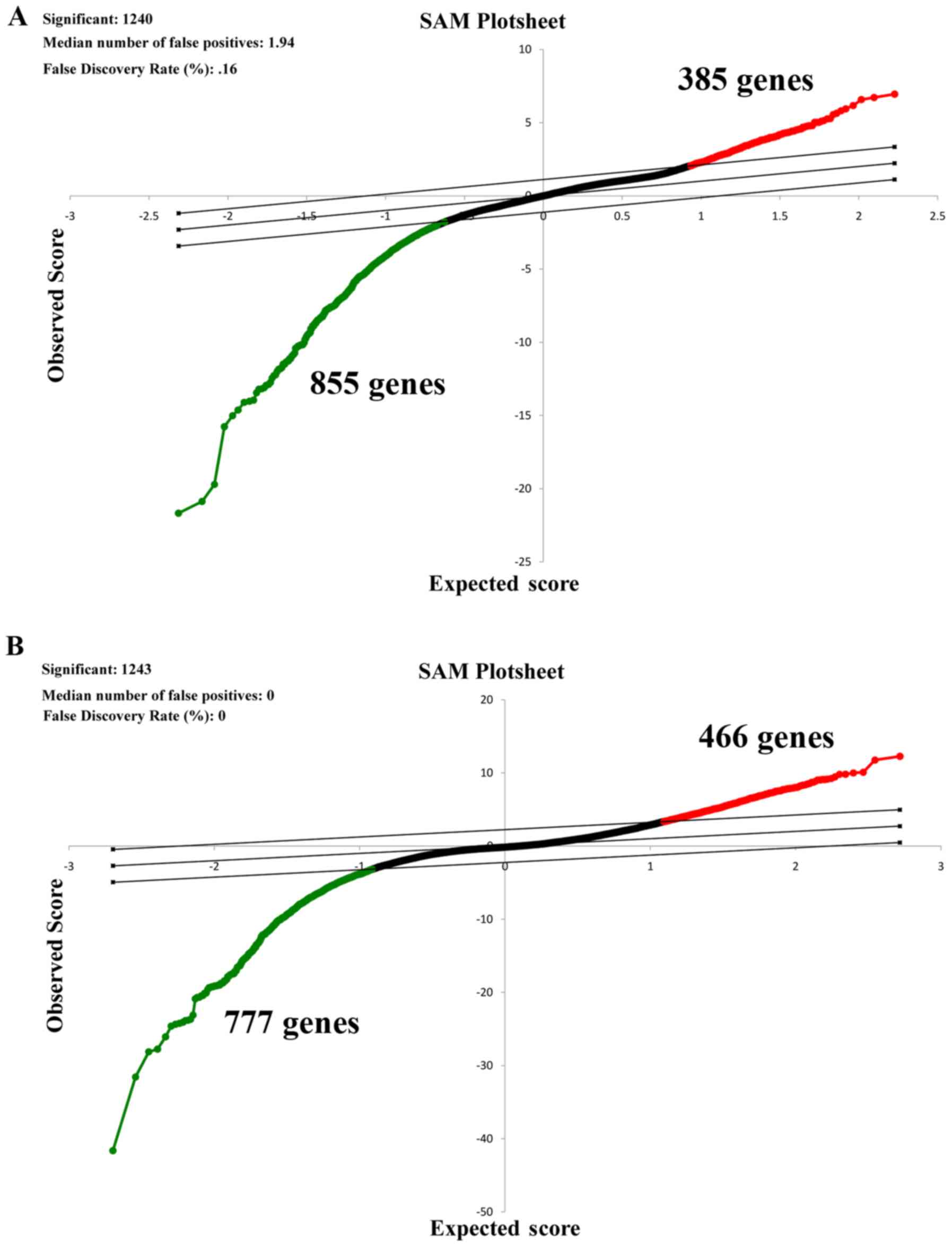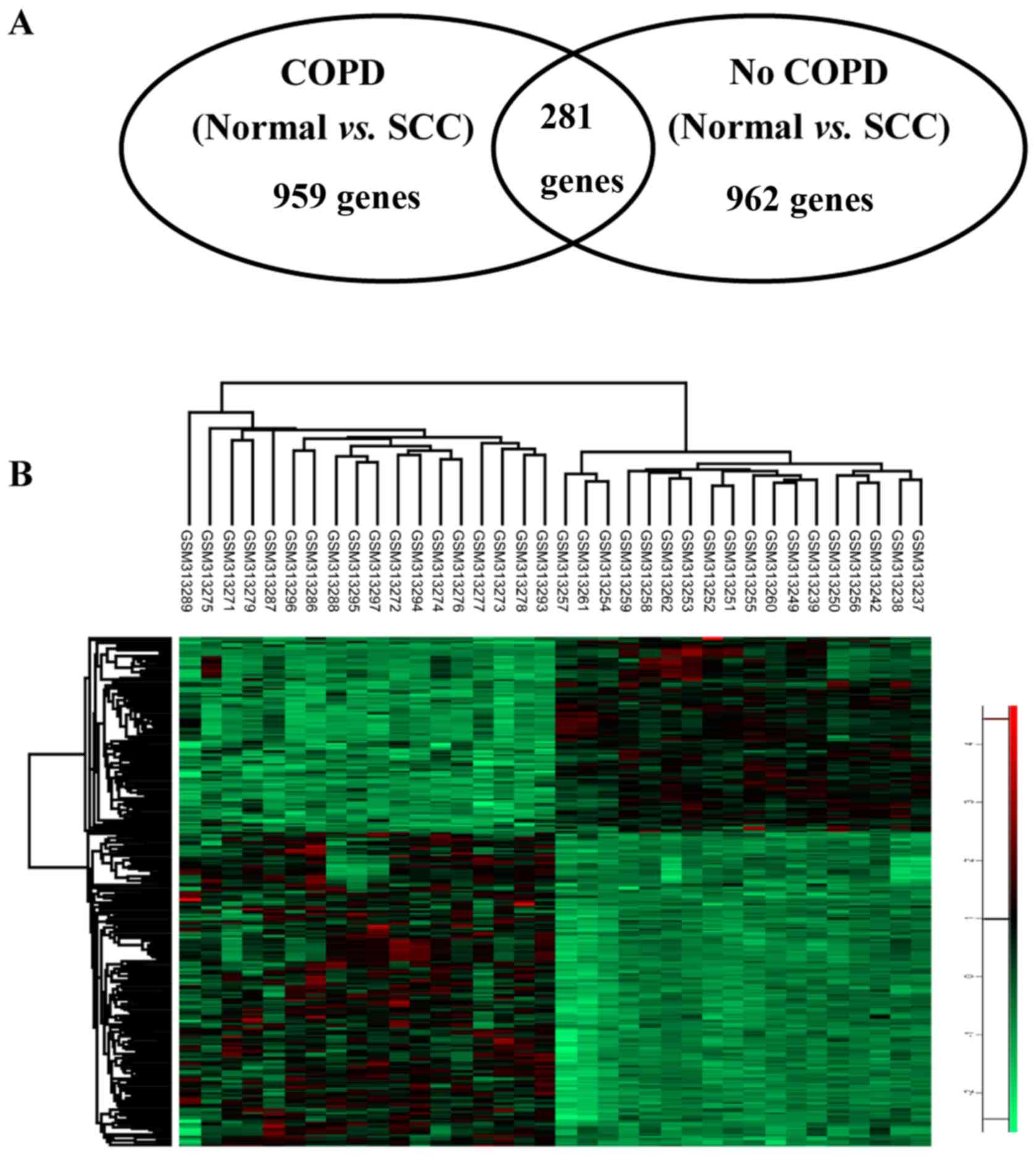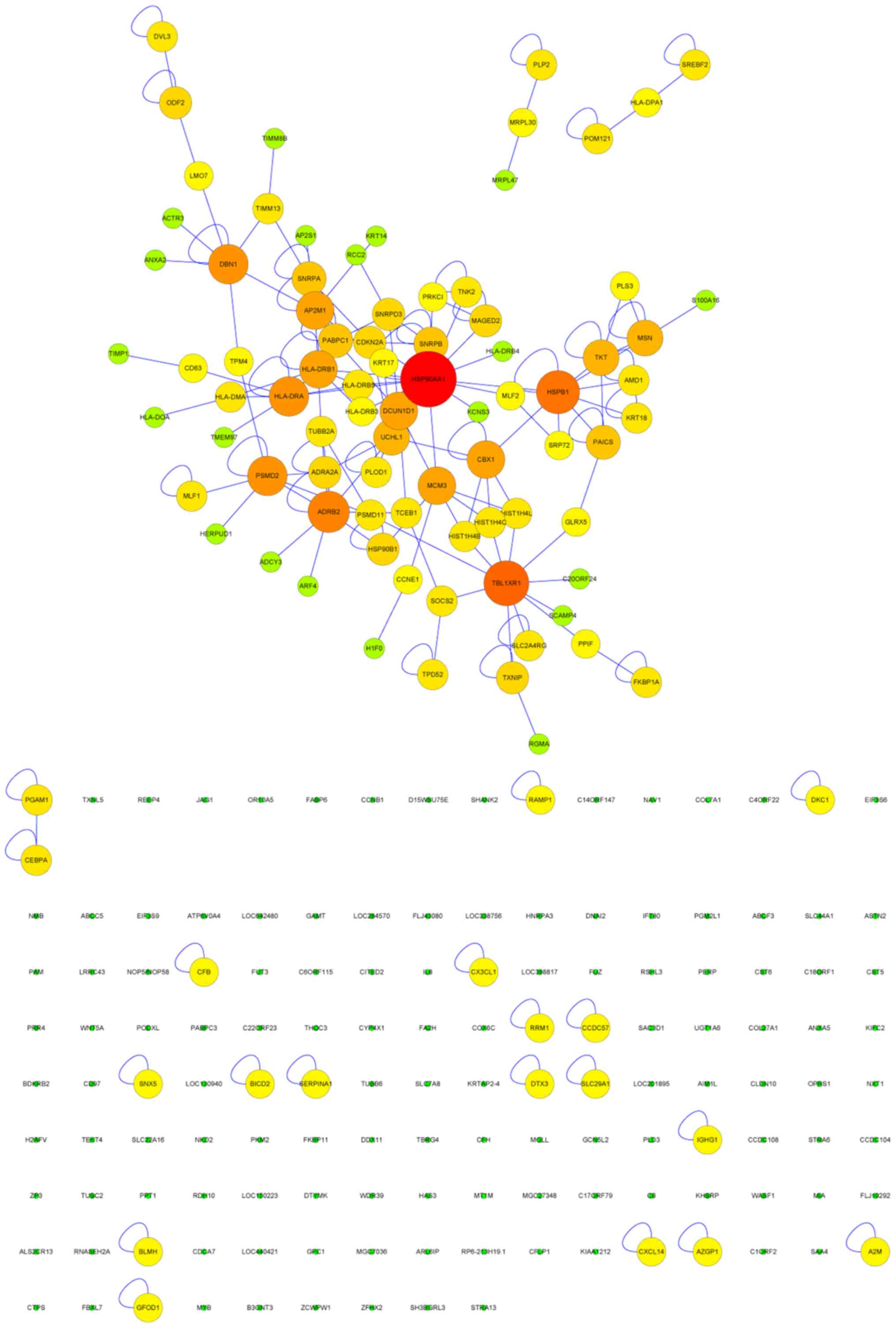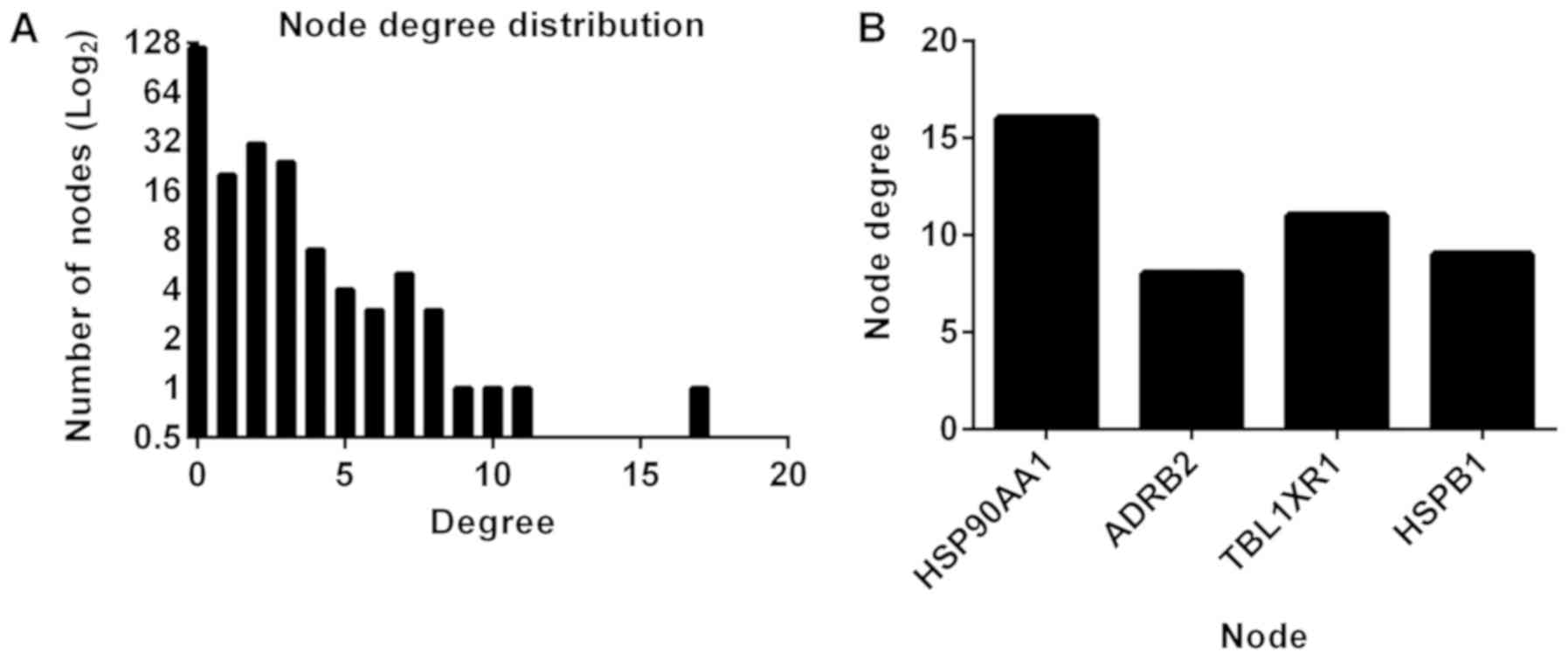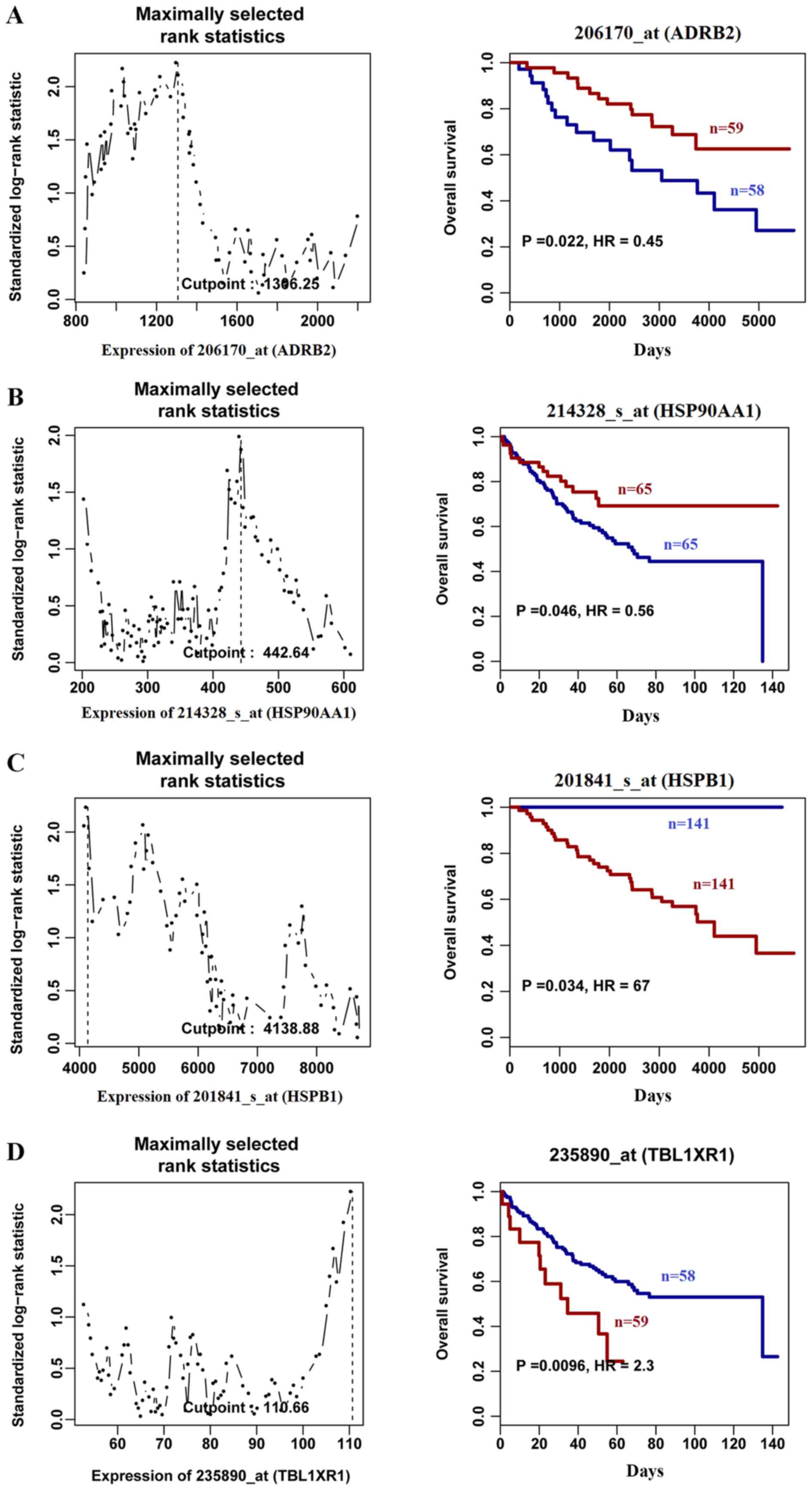Introduction
As the third leading cause of mortality in the
United States in 2018, chronic obstructive pulmonary disease (COPD)
is a chronic inflammatory lung disease characterized by obstruction
of lung airflow (1). In 2017,
squamous cell lung cancer, or squamous cell carcinoma of the lung
(SCC), which is a type of non-small cell lung cancer (NSCLC),
accounted for ~30% of all lung cancer cases worldwide (2). However, the connection between COPD and
SCC remains poorly defined (3).
Current literature has extended the idea that
inflammation is a basic part of tumorigenesis (3). Inflammatory cells, which interact with
the tumor environment, foster proliferation, survival and migration
of tumor cells (4). Tumor cells use
certain signaling molecules of the innate immune system, such as
selectins and chemokines, to foster proliferation, migration and
metastasis (4). However, little is
known about the role of inflammation in lung cancer
progression.
Systems biology has been applied to biological
systems for the investigation of cancer (5). A biological system is any system that
applies to organic frameworks (6).
Systems biology enables the identification of the molecular and
cellular networks involved in disease progression (7–9). The
present study generated a genetic interaction network using
microarray gene expression data from patients with SCC and COPD,
and explored the potential molecular mechanisms involved using a
gene regulatory networks approach.
Materials and methods
Microarray dataset
The microarray dataset (GSE12472) (6) used in the current study was downloaded
from the Gene Expression Omnibus repository (www.ncbi.nlm.nih.gov/geo). All differently expressed
genes associated with SCC with or without COPD were screened from
this dataset. In the original study, the authors compared gene
expression profiles in bronchial epithelia from patients with SCC
with and without COPD (6). Bronchial
tissues from the larger airways (bronchus diameter >2 mm,
surrounded by cartilage) were resected from 10 individuals without
COPD and 18 with COPD. Additionally, centrally located primary
tumor tissues were collected from 35 patients with SCC, including
17 patients without COPD and 18 with COPD. The most recent
post-bronchodilator spirometric results prior to surgery were used
to assess the GOLD stage for each patient. Bronchial tissues from
17 patients without COPD were obtained during thoracotomy for
NSCLC. Bronchial tissues from 18 patients with COPD were obtained
during thoracotomy for NSCLC (n=11) or lung transplantation (n=7).
Total RNA was isolated and purified from the samples, and the
Agilent Whole Human Genome Oligo microarray (GPL1708; Agilent
Technologies, Inc.) was used to determine gene expression
levels.
Identification of differentially
expressed genes
The raw microarray data was downloaded directly from
GSE12472 as the matrix .txt files. Significance analysis of
microarrays (SAM; version 2.11; statweb.stanford.edu/~tibs/SAM) was used to identify
upregulated and downregulated genes from the comparison between
bronchial epithelia of patients with SCC with and without COPD
(7). To identify COPD-associated
genes that drive SCC progression, genes identified in both the
normal bronchial epithelium and COPD tissue were excluded from the
list of genes in SCC with COPD using the Advanced Network Merge
function in Cytoscape.
Differently expressed gene
visualization
Differently expressed genes were visualized using
Cluster and TreeView (version 3.0; bonsai.hgc.jp/~mdehoon/software/cluster/software.htm)
as previously described (8).
Gene-gene interaction network
construction
The COPD-associated genetic interaction network in
SCC was expanded using the BisoGenet plug-in in Cytoscape 3.0
(www.cytoscape.org) as previously reported
(8). BisoGenet allows users to
customize searches by specifying a target set of genes/proteins to
retrieve interaction data, and allows searching for molecular
interactions in SysBiomics embedded within Cytoscape (9). SysBiomics integrates data from
well-known interaction databases, including the Database of
Interacting Proteins (dip.mbi.ucla.edu/dip), BIOGRID (thebiogrid.org), the Human Protein Reference Database
(www.hprd.org), the Biomolecular Interaction
Network Database (bind.ca), the Molecular INTeraction
database (mint.bio.uniroma2.it/mint) and EMBL-EBI INTACT
(https://www.ebi.ac.uk/intact/).
Network topological parameters
Topological parameters were calculated using the
Network Analysis function of Cytoscape 3.0. Node size and color was
mapped based on the degree of connectivity (8).
Survival analysis
The prognostic value of gene signatures in SCC was
assessed using PROGgene version 2.0 (watson.compbio.iupui.edu/chirayu/proggene/database/index.php)
(10,11). The overall survival rate was compared
between patients with high and low mRNA expression of the selected
genes using the median gene expression as the cut-off value. For
survival analysis, Kaplan-Meier survival curves and the log-rank
test were used in this study.
Statistical analysis
For SAM, gene expression was considered
significantly different when the false discovery rate (FDR) was ≤5%
and the fold change was ≥2.
Results
Differentially expressed genes
associated with SCC progression
Gene expression in patients with SCC and normal
tissues with COPD was compared. As presented in Fig. 1A, a total of 385 upregulated and 855
downregulated genes were identified by SAM when a FDR ≤5% and fold
change ≥2 were employed.
Differentially expressed genes
associated with COPD-related SCC progression
Patients with SCC and normal tissues without COPD
were compared. According to the SAM plot (Fig. 1B), a total of 1,243 differently
expressed genes (466 upregulated and 777 downregulated) were
identified.
Aberrant COPD-related genes facilitate
SCC progression
To identify COPD-associated genes that drive SCC
progression, genes identified in both the normal bronchial
epithelium and COPD tissue were excluded from the list of genes in
SCC with COPD. A total of 281 differentially expressed genes for
SCC with COPD remained (Fig. 2).
Genetic interaction network of genes
in SCC and COPD
A genetic interaction network investigating the
interactions between genes in SCC with COPD was constructed and
expanded using BisoGenet. The interaction network consisted of 220
nodes and 163 edges (Fig. 3). The
clustering coefficient and network diameter were 0.04 and 10,
respectively. The node degree distribution across the entire
network was calculated (Fig. 4A).
The four nodes with the greatest degree of connectivity [Heat shock
protein 90 α family class A member 1 (HSP90AA1);
adrenoceptor β2 (ADRB2); transducin β like 1 X-linked
receptor 1 (TBL1XR1) and heat shock protein family B (small)
member 1 (HSPB1)] were identified (Fig. 4B), and were selected for evaluation
of their effect on survival.
Association of HSP90AA1, ADRB2,
TBL1XR1 and HSPB1 with the overall survival rate in COPD-related
SCC
The association between the expression of the
aforementioned genes and overall survival rate was evaluated using
PROGgene. Compared with patients with SCC with high gene
expression, patients with lower gene expression of ADRB2
(Fig. 5A) and HSP90AA1
(Fig. 5B) had a decreased overall
survival rate. However, high expression of HSPB1 (Fig. 5C) and TBL1XR1 (Fig. 5D), which were highly expressed in SCC
compared with COPD tissues, was associated with decreased overall
survival rate compared with low expression. The survival analysis
also revealed that patients with low expression of HSPB1 in
SCC were still alive at the end of the follow-up period (13.6
years), suggesting that HSPB1 may be a potential therapeutic
target in SCC. The results obtained in the present study
demonstrate the clinical significance of HSP90AA1, ADRB2,
TBL1XR1 and HSPB1 in COPD-related SCC.
Discussion
COPD is a chronic lung disease that results in
decreased airflow in the lungs. Symptoms include trouble with
breathing, coughing, mucus (sputum) generation and wheezing
(12). This is caused by exposure to
irritant compounds or particulate matter, predominantly from
tobacco smoke (13). Individuals
with COPD are at an increased risk of developing lung tumors and
other conditions, such as emphysema and chronic bronchitis
(13). COPD is a risk factor for SCC
and the association between the two remains unclear (13). Therefore, the association between
COPD and SCC needed to be elucidated the present study identified
marker genes uniquely associated with SCC with COPD. The results of
the present study indicated that high levels of ADRB2 and
HSP90AA1 were associated with a longer survival time
compared with the respective low expression groups. However, high
expression of TBL1XR1 and HSPB1 predicted poor
overall survival in patient with SCC.
The microarray analysis employed in the current
study revealed that ADRB2 and HSP90AA1 are
downregulated in SCC tissues compared with healthy adjacent
non-cancerous tissue, suggesting that they may serve important
roles in the progression of SCC. Previous studies reported that
ADRB2 is an important regulator of airway smooth muscle tone
(14–16). High levels of ADRB2 are
associated with reduced lung function, asthma and COPD (14). Additionally, ADRB2 is an
anti-inflammatory gene and was previously reported to be involved
in hyperinflammation (17) and
autoimmune disorders such as rheumatoid arthritis (18). Furthermore, ADRB2 has been
demonstrated to be downregulated in prostate and breast cancer, and
functional gain of ADRB2 decreases cancer progression
(19,20). However, the association between
ADRB2 and COPD-associated SCC remains unknown. In the
present study, TBL1XR1 mRNA was highly expressed in samples
from patients with SCC with COPD, but not SCC without COPD.
TBL1XR1 is a member of the WD40 repeat-containing gene
family. The protein encoded by this gene composes an integral
subunit of both nuclear receptor corepressor and histone
deacetylase 3 complexes, and serves an essential role in regulating
the activation of transcriptional and intracellular signaling
pathways, such as JNK and ribonuclease pathways (21,22).
Upregulation of TBL1XR1 gene expression has been observed in
various cancer cell lines and solid tumors from patients (23,24),
lymphoma (25) and acute leukemia
(26), and are associated with
advanced tumor stage, metastasis and poor prognosis. In SCC,
elevated mRNA and protein expression of TBL1XR1 was confirmed in
cells lines and patient samples (27). While a direct association between
COPD and TBL1XR1 has not been revealed, this gene has been
reported to regulate several important signaling pathways that
modulate the growth of lung α-smooth muscle actin-positive cells
and airway reconstruction (28).
Previously, Zou et al (29)
reported that HSP90AA1 affects the response of patients with
systemic lupus erythematosus to glucocorticoid treatment and the
lipopolysaccharide-induced inflammatory response, including tumor
necrosis factor secretion by monocytes. Furthermore, the role of
HSP90AA1 in cancer pathogenesis is currently an area of
active investigation. A study suggested that high expression of
HSP90AA1 was an independent factor associated with mortality
in patients with breast cancer (triple-negative and human epidermal
growth factor receptor 2-negative/estrogen receptor-positive
subtypes) (30).
HSPB1 encodes HSP20, a member of the heat
shock protein family (31,32). The association between increased
expression levels of HSPA1A and HSPB1 in plasma and
lymphocytes and the risk of COPD has been reported and verified by
lung tissue proteomics (31).
Additionally, upregulated expression of HSPB1 was observed
in SCC and the endothelial-to-mesenchymal transition, and was
associated with poor survival (33).
Upregulation of HSPB1 has also been observed in leukemia,
cervical cancer, breast cancer and NSCLC. In the present study, the
possible clinical importance of HSPB1 in COPD-related SCC
are in agreement with previous studies, which suggests that it
requires further research (34).
In the present study, patients with SCC who
exhibited low expression of HSPB1 were still alive after
13.6 years, suggesting that HSPB1 may be a potential
therapeutic target in SCC. The efficacy of HSPB1 as a
therapeutic target requires further investigation and validation by
in vivo experiments.
In conclusion, ADRB2, HSP90AA1, TBL1XR1 and
HSPB1 may serve important roles in COPD-associated SCC and
may provide novel therapeutic targets for the treatment of lung
cancer. The limited number of studies existing on these four genes
in COPD-related SCC progression is a limitation that impacts the
interpretation of the findings from the current in silico
study and limits the applications of these signatures within
clinical practice.
Acknowledgements
Not applicable.
Funding
The present study was supported by the Hunan
Provincial Science and Technology Department Project (grant no.
2015SK20402).
Availability of data and materials
The datasets analyzed during the current study are
available in the GEO repository with no. GSE12472.
Authors' contributions
LW and HZ conceived and designed the study, and
analyzed and interpreted the data. LW and HZ analyzed the
microarray data. LZ, HL, QC and XZ performed the survival analysis.
LW and HZ wrote the manuscript. All the authors approved the
manuscript.
Ethics approval and consent to
participate
This study was approved by the Institutional Review
Board Committee of the Xiangya Hospital of Central South
University. The data were obtained from a publicly available
dataset; therefore, no written informed consent was required.
Patient consent for publication
Not applicable.
Competing interests
The authors declare that they have no competing
interests.
References
|
1
|
Balkissoon R, Lommatzsch S, Carolan B and
Make B: Chronic obstructive pulmonary disease: A concise review.
Med Clin North Am. 95:1125–1141. 2011. View Article : Google Scholar : PubMed/NCBI
|
|
2
|
Harjes U: Non-small cell lung cancer:
Where there's smoke. Nat Rev Cancer. 17:634–635. 2017. View Article : Google Scholar : PubMed/NCBI
|
|
3
|
Houghton AM: Mechanistic links between
COPD and lung cancer. Nat Rev Cancer. 13:233–245. 2013. View Article : Google Scholar : PubMed/NCBI
|
|
4
|
Dou Z, Ghosh K, Vizioli MG, Zhu J, Sen P,
Wangensteen KJ, Simithy J, Lan Y, Lin Y, Zhou Z, et al: Cytoplasmic
chromatin triggers inflammation in senescence and cancer. Nature.
550:402–406. 2017. View Article : Google Scholar : PubMed/NCBI
|
|
5
|
Barabasi AL, Gulbahce N and Loscalzo J:
Network medicine: A network-based approach to human disease. Nat
Rev Genet. 12:56–68. 2011. View
Article : Google Scholar : PubMed/NCBI
|
|
6
|
Boelens MC, Gustafson AM, Postma DS, Kok
K, van der Vries G, van der Vlies P, Spira A, Lenburg ME, Geerlings
M, Sietsma H, et al: A chronic obstructive pulmonary disease
related signature in squamous cell lung cancer. Lung Cancer.
72:177–183. 2011. View Article : Google Scholar : PubMed/NCBI
|
|
7
|
Tusher VG, Tibshirani R and Chu G:
Significance analysis of microarrays applied to the ionizing
radiation response. Proc Natl Acad Sci USA. 98:5116–5121. 2001.
View Article : Google Scholar : PubMed/NCBI
|
|
8
|
Fan S and Li X, Tie L, Pan Y and Li X:
KIAA0101 is associated with human renal cell carcinoma
proliferation and migration induced by erythropoietin. Oncotarget.
7:13520–13537. 2016.PubMed/NCBI
|
|
9
|
Martin A, Ochagavia ME, Rabasa LC, Miranda
J, Fernandez-de-Cossio J and Bringas R: BisoGenet: A new tool for
gene network building, visualization and analysis. BMC
Bioinformatics. 11:912010. View Article : Google Scholar : PubMed/NCBI
|
|
10
|
Goswami CP and Nakshatri H: PROGgene: Gene
expression based survival analysis web application for multiple
cancers. J Clin Bioinforma. 3:222013. View Article : Google Scholar : PubMed/NCBI
|
|
11
|
Goswami CP and Nakshatri H: PROGgeneV2:
Enhancements on the existing database. BMC Cancer. 14:9702014.
View Article : Google Scholar : PubMed/NCBI
|
|
12
|
Zeng Z, Yang D, Huang X and Xiao Z: Effect
of carbocisteine on patients with COPD: A systematic review and
meta-analysis. Int J Chron Obstruct Pulmon Dis. 12:2277–2283. 2017.
View Article : Google Scholar : PubMed/NCBI
|
|
13
|
Ho T, Cusack RP, Chaudhary N, Satia I and
Kurmi OP: Under- and over-diagnosis of COPD: A global perspective.
Breathe (Sheff). 15:24–35. 2019. View Article : Google Scholar : PubMed/NCBI
|
|
14
|
Nielsen AO, Jensen CS, Arredouani MS, Dahl
R and Dahl M: Variants of the ADRB2 gene in COPD: Systematic review
and meta-analyses of disease risk and treatment response. COPD.
14:451–460. 2017. View Article : Google Scholar : PubMed/NCBI
|
|
15
|
Zhao H, Wu X, Dong CL, Wang BY, Zhao J and
Cao XE: Association between ADRB2 genetic polymorphisms and the
risk of chronic obstructive pulmonary disease: A case-control study
in a chinese population. Genet Test Mol Biomarkers. 21:491–496.
2017. View Article : Google Scholar : PubMed/NCBI
|
|
16
|
Hussein MH, Sobhy KE, Sabry IM, El Serafi
AT and Toraih EA: Beta2-adrenergic receptor gene
haplotypes and bronchodilator response in Egyptian patients with
chronic obstructive pulmonary disease. Adv Med Sci. 62:193–201.
2017. View Article : Google Scholar : PubMed/NCBI
|
|
17
|
Agac D, Estrada L and Farrar D: Beta-2
adrenergic receptor signaling prevents hyperinflammation through
early release of IL-10. J Immunology. 198:221–224. 2017.
|
|
18
|
Pont-Kingdon G, Bohnsack J, Sumner K,
Whiting A, Clifford B, Guthery SS, Jorde LB, Lyon E and Prahalad S:
Lack of association between beta 2-adrenergic receptor
polymorphisms and juvenile idiopathic arthritis. Scand J Rheumatol.
38:91–95. 2009. View Article : Google Scholar : PubMed/NCBI
|
|
19
|
Braadland PR, Ramberg H, Grytli HH and
Tasken KA: β-Adrenergic receptor signaling in prostate cancer.
Front Oncol. 4:3752015. View Article : Google Scholar : PubMed/NCBI
|
|
20
|
Pérez-Sayáns M, Somoza-Martín JM,
Barros-Angueira F, Diz PG, Gándara Rey JM and García-García A:
Beta-adrenergic receptors in cancer: Therapeutic implications.
Oncol Res. 19:45–54. 2010. View Article : Google Scholar : PubMed/NCBI
|
|
21
|
Zhang X, Dormady SP and Basch RS:
Identification of four human cDNAs that are differentially
expressed by early hematopoietic progenitors. Exp Hematol.
28:1286–1296. 2000. View Article : Google Scholar : PubMed/NCBI
|
|
22
|
Zhang J, Kalkum M, Chait BT and Roeder RG:
The N-CoR-HDAC3 nuclear receptor corepressor complex inhibits the
JNK pathway through the integral subunit GPS2. Mol Cell. 9:611–623.
2002. View Article : Google Scholar : PubMed/NCBI
|
|
23
|
Ma M and Yu N: Over-expression of TBL1XR1
indicates poor prognosis of serous epithelial ovarian cancer.
Tohoku J Exp Med. 241:239–247. 2017. View Article : Google Scholar : PubMed/NCBI
|
|
24
|
Liu F, He Y, Cao Q, Liu N and Zhang W:
TBL1XR1 is highly expressed in gastric cancer and predicts poor
prognosis. Dis Markers. 2016:24365182016. View Article : Google Scholar : PubMed/NCBI
|
|
25
|
Scott DW, Mungall KL, Ben-Neriah S, Rogic
S, Morin RD, Slack GW, Tan KL, Chan FC, Lim RS, Connors JM, et al:
TBL1XR1/TP63: A novel recurrent gene fusion in B-cell non-Hodgkin
lymphoma. Blood. 119:4949–4952. 2012. View Article : Google Scholar : PubMed/NCBI
|
|
26
|
Campregher PV, Halley ND, Vieira GA,
Fernandes JF, Velloso ED, Ali S, Mughal T, Miller V, Mangueira CL,
Odone V and Hamerschlak N: Identification of a novel fusion
TBL1XR1-PDGFRB in a patient with acute myeloid leukemia harboring
the DEK-NUP214 fusion and clinical response to dasatinib. Leuk
Lymphoma. 58:2969–2972. 2017. View Article : Google Scholar : PubMed/NCBI
|
|
27
|
Wang S, Han H, Hu Y, Yang W, Lv Y, Wang L,
Zhang L and Ji J: MicroRNA-130a-3p suppresses cell migration and
invasion by inhibition of TBL1XR1-mediated EMT in human gastric
carcinoma. Mol Carcinog. 57:383–392. 2018. View Article : Google Scholar : PubMed/NCBI
|
|
28
|
Moiseenko A, Kheirollahi V, Chao CM,
Ahmadvand N, Quantius J, Wilhelm J, Herold S, Ahlbrecht K, Morty
RE, Rizvanov AA, et al: Origin and characterization of alpha smooth
muscle actin-positive cells during murine lung development. Stem
Cells. 35:1566–1578. 2017. View Article : Google Scholar : PubMed/NCBI
|
|
29
|
Zou YF, Xu JH, Gu YY, Pan FM, Tao JH, Wang
DG, Xu SQ, Xiao H, Chen PL, Liu S, et al: Single nucleotide
polymorphisms of HSP90AA1 gene influence response of SLE patients
to glucocorticoids treatment. Springerplus. 5:2222016. View Article : Google Scholar : PubMed/NCBI
|
|
30
|
Cheng Q, Chang JT, Geradts J, Neckers LM,
Haystead T, Spector NL and Lyerly HK: Amplification and high-level
expression of heat shock protein 90 marks aggressive phenotypes of
human epidermal growth factor receptor 2 negative breast cancer.
Breast Cancer Res. 14:R622012. View Article : Google Scholar : PubMed/NCBI
|
|
31
|
Cui X, Xing J, Liu Y, Zhou Y, Luo X, Zhang
Z, Han W, Wu T and Chen W: COPD and levels of Hsp70 (HSPA1A) and
Hsp27 (HSPB1) in plasma and lymphocytes among coal workers: A
case-control study. Cell Stress Chaperones. 20:473–481. 2015.
View Article : Google Scholar : PubMed/NCBI
|
|
32
|
Diakos CI, Charles KA, McMillan DC and
Clarke SJ: Cancer-related inflammation and treatment effectiveness.
Lancet Oncol. 15:e493–e503. 2014. View Article : Google Scholar : PubMed/NCBI
|
|
33
|
Choi SH, Nam JK, Kim BY, Jang J, Jin YB,
Lee HJ, Park S, Ji YH, Cho J and Lee YJ: HSPB1 inhibits the
endothelial-to-mesenchymal transition to suppress pulmonary
fibrosis and lung tumorigenesis. Cancer Res. 76:1019–1030. 2016.
View Article : Google Scholar : PubMed/NCBI
|
|
34
|
Desmedt C, Piette F, Loi S, Wang Y,
Lallemand F, Haibe-Kains B, Viale G, Delorenzi M, Zhang Y,
d'Assignies MS, et al: Strong time dependence of the 76-gene
prognostic signature for node-negative breast cancer patients in
the TRANSBIG multicenter independent validation series. Clin Cancer
Res. 13:3207–3214. 2007. View Article : Google Scholar : PubMed/NCBI
|















